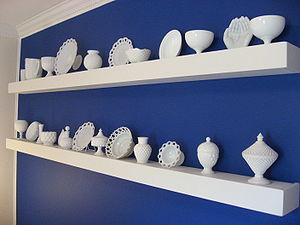
Milk glass
Encyclopedia

Glass
Glass is an amorphous solid material. Glasses are typically brittle and optically transparent.The most familiar type of glass, used for centuries in windows and drinking vessels, is soda-lime glass, composed of about 75% silica plus Na2O, CaO, and several minor additives...
, blown or pressed into a wide variety of shapes.
First made in Venice
Venice
Venice is a city in northern Italy which is renowned for the beauty of its setting, its architecture and its artworks. It is the capital of the Veneto region...
in the 16th century, colors include blue, pink, yellow, brown, black, and the white that led to its popular name.
History
First made in VeniceVenice
Venice is a city in northern Italy which is renowned for the beauty of its setting, its architecture and its artworks. It is the capital of the Veneto region...
in the 16th century, colors include blue, pink, yellow, brown, black, and white.
19th-century glass makers called milky white opaque glass "opal glass".
The name milk glass is relatively recent.
The white color is achieved through the addition of an opacifier
Opacifier
An opacifier is a substance added to a material in order to make the ensuing system opaque. An example of a chemical opacifier is tin dioxide , which is used to opacify ceramic glazes and milk glass; bone ash is also used....
, e.g. tin dioxide
Tin dioxide
Tin dioxide is the inorganic compound with the formula SnO2. The mineral form of SnO2 is called cassiterite, and this is the main ore of tin. With many other names , this oxide of tin is the most important raw material in tin chemistry...
or bone ash
Bone ash
Bone ash is the white, powdery ash left from the burning of bones. It is primarily composed of calcium phosphate. It is commonly used in fertilizers, polishing compounds, and in making ceramics...
.
Made into decorative dinnerware, lamp
Light fixture
A light fixture, light fitting, or luminaire is an electrical device used to create artificial light and/or illumination, by use of an electric lamp...
s, vase
Vase
The vase is an open container, often used to hold cut flowers. It can be made from a number of materials including ceramics and glass. The vase is often decorated and thus used to extend the beauty of its contents....
s, and costume jewelry
Costume jewelry
Costume jewelry is jewelry manufactured as ornamentation to complement a particular fashionable costume or garment. Costume jewelry came into being in the 1930s as a cheap, disposable accessory meant to be worn with a specific outfit...
, milk glass was highly popular during the fin de siecle
Fin de siècle
Fin de siècle is French for "end of the century". The term sometimes encompasses both the closing and onset of an era, as it was felt to be a period of degeneration, but at the same time a period of hope for a new beginning...
.
Pieces made for the wealthy of the Gilded Age
Gilded Age
In United States history, the Gilded Age refers to the era of rapid economic and population growth in the United States during the post–Civil War and post-Reconstruction eras of the late 19th century. The term "Gilded Age" was coined by Mark Twain and Charles Dudley Warner in their book The Gilded...
are known for their delicacy and beauty in color and design, while Depression glass
Depression glass
Depression glass is clear or colored translucent glassware that was distributed free, or at low cost, in the United States around the time of the Great Depression. The Quaker Oats Company, and other food manufacturers and distributors, put a piece of glassware in boxes of food, as an incentive to...
pieces of the 1930s and '40s are less so.
Collectible
Milk glass has a considerable following of collectors.Glass makers continue to produce both original pieces and reproductions of popular collectible pieces and patterns.
Notable manufacturers

- Kanawha Glass Co.Dunbar GlassDunbar Glass Co. was a glassmaking company in Dunbar, West Virginia. It operated from 1913 to 1953.Some of the company's craftsmen formed Kanawha Glass Company when the Dunbar Glass company folded....
- Fenton Glass Company
- Fostoria Glass CompanyFostoria Glass CompanyThe Fostoria Glass Company manufactured pressed, blown and hand-molded glassware and tableware for almost 90 years. It began operations in Fostoria, Ohio, USA, on December 15, 1887, at South Vine Street, near Railroad, on free land donated by the townspeople...
- Imperial Glass CompanyImperial Glass CompanyThe Imperial Glass Company is located in Bellaire, Ohio with a factory located on 29th Street and the offices located on Belmont Street. The factory was razed in 1995 to make room for commercial development and the Belmont Street location was transformed into a museum known as the National Imperial...
- Mosser GlassMosser GlassMosser Glass is a company making handmade glass, founded in Cambridge, Ohio, in 1970 by Thomas R. Mosser. The company is currently operated by his oldest son, Tim Mosser. The Mosser family got their start in the business at the Cambridge Glass Company....
- Westmoreland Glass CompanyWestmoreland Glass CompanyThe Westmoreland Glass Company was founded in 1889 when a group of men from the Specialty Glass Company in East Liverpool, Ohio migrated to Grapeville, Pennsylvania. The property had a large source of natural gas. The company was run by two brothers, George and Charles West. Its main production was...

